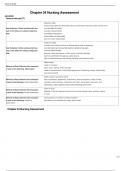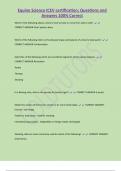8/6/24, 8:00 AM
Chapter 34 Nursing Assessment
Jeremiah
Terms in this set (77)
Objective Data
all the measurable and observable pieces of information about the client and his or her
Data Collection –Define and describe how overall state of health.
each of the follow are utilized. Objective accurate measurements
Data quantifiable descriptions
measurable and observable
does not need interpretation
Subjective Data
consists of the client's opinions or feelings about what is happening.
Data Collection –Define and describe how only the client can tell you that he/she is afraid or has pain
each of the follow are utilized. Subjective communicates through:
Data gestures, facial expressions, written words, and body language
Can't be confirmed through any other source
data is obtained through interviewing, listening, and observing skills
Observation
relies on 5 senses:
Methods of Data Collection-Give examples
sight, touch, hearing, smell, and taste
of each of the following: Observation
relate to characteristics of the client's appearance, functioning, primary relationships,
and environment
Sight provides clues about client
Methods of Data Collection-Give examples body movements, appearance, mannerisms, facial expressions, mode of dress,
of each of the following: Visual observation nonverbal communication, interaction with other, use of space, skin color, and
cleanliness, collect objective data while inspecting client's skin
sense of touch
Methods of Data Collection-Give examples
palpation of the skin assesses factors such as muscle strength, temp, moisture, edema,
of each of the following: Tactile observation
or rash.
Methods of Data Collection-Give examples hearing allows us to listen to clients complaint
of each of the following: Auditory also allows us to auscultate the lungs, heart, bowel
observation
Chapter 34 Nursing Assessment
1/10
, 8/6/24, 8:00 AM
Methods of Data Collection-Give examples Sense of smell
of each of the following: Olfactory or microorganisms produce a smell
Gustatory observation note body/breathe odors, alcohol, hygiene, or metabolic acidosis
a way of soliciting information from client
A complete health history helps develop an effective plan of care for the client. It
includes:
Biographical data
Methods of Data Collection-Give examples
Reason for coming to the healthcare facility
of each of the following: Health Interview
Recent health history
Important medical history
Pertinent psychosocial information
Activities of daily living (ADL)
Biographical Data:
name, age, birthdate, spouse, children, address, number, occupation, financial status
Reason:
address the primary reason or chief complaint or perception of the illness
Recent health history:
symptoms of recent disease treated with medications and/or surgery
What are the Components of the nursing Important medical history:
history family history, allergies, immunization, medications
Psychosocial info:
family relationships, employment, living conditions, emotional stability, sexual
relationships, substance usage.
Activities of daily living:
able to meet basic needs such as eating, drinking, bathing, dressing, exercise, food,
rest, and sleep
What is the Physical Examination continually monitor the condition of your clients as you care for them
draw conclusions about the client's health problems
During and after data collection, critically examine each piece of information to
determine its relevance to the client's health problems and its relationship to other
pieces of information.
What is Data Analysis
**Example: A client who is having heartburn should be asked about a history of
digestive problems
Through systematic data analysis, draw conclusions about the client's health problems.
During data analysis, use critical thinking skills.
Analyze the data collected and begin to determine which items are pertinent to client
care and which are not by critically thinking
Recognizing Significant Data, explain Recognizing significant data
When preparing to analyze data, ask yourself which items are pertinent to client
care and which are not.
validate observations with clients complaints and symptoms
How do you perform Validating Observation Validating observations
Validate observations by checking if they agree with what the client is experiencing.
some data are similar or have a pattern or connection and are identified as symptoms
do the symptoms occur at a certain time or after a certain task
How to Recognizing Patterns of Cluster
Recognizing patterns or clusters
Symptoms can be grouped together in clusters for further analysis.
look for strengths the client has that he/she can use with coping problems
Identifying strengths and problems
Identifying Strengths and Problems, explain
While assessing the client, the nurse should look for strengths the client has that can
be used in coping with problems.
2/10





